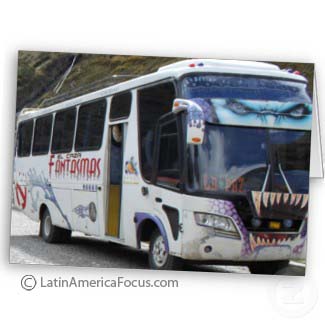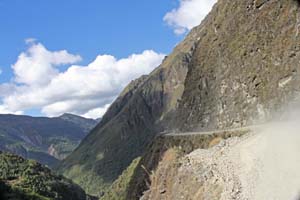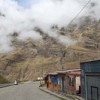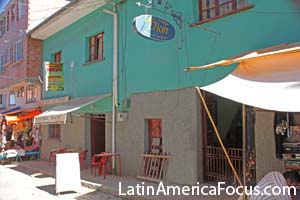Get the La Paz Bus to Chulumani
To Villa Fatima:
La Paz city taxi to Villa Fatima $10 BS (total, regardless of persons in vehicle)
To Chulumani from La Paz:
Large Bus from La Paz to Chulumani: Copacabana bus company $25 BS per person.
Tickets can be purchased and seats reserved in advance.
To Villa Fatima:
La Paz city taxi to Villa Fatima $10 BS (total, regardless of persons in vehicle)
To Chulumani from La Paz:
Large Bus from La Paz to Chulumani: Copacabana bus company $25 BS per person.
Tickets can be purchased and seats reserved in advance.
Villa Fatima Bus to Chulumani Experience:
Upon arriving in La Paz (July 2011), I had little concern of our journey to the town of Chulumani. I ignored my friend’s comments on how “the book” described death-defying road drops into the Yungas. Had I not bicycled the Bolivia death-road to Coroico in 2010 – the road known as the “most dangerous road in the world?”
I was confident our concern should be focused on getting on the bus, not the ride.
Locals and tourist agencies answered our inquiries with numerous adaptations of the traditional Latin American autobus attitude, “It comes when it comes.” Each person expressed with confidence: “There are only two buses a day,” “No buses after 2 p.m.,” or “They depart when full.”
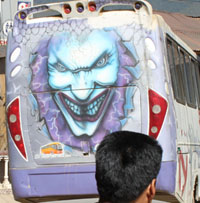
Around 12:30 p.m., we took a 15-minute taxi ride for 10 Bolivianos (BS) to Villa Fatima, the area of town where buses depart to the Yungas. (It seems taxi’s to anywhere in La Paz city costs 10BS in 2011, regardless of passengers or distance.) We wondered if we are pushing our luck. Were there really no buses after 2 p.m.?
“Chulumani, Chulumani, Chulumani!” a man yelled.
Crowds jostled bundles of coca leaves. Several huge buses, each painted in a dominant color (orange, red, blue, etc.) lined the streets, adding to the hues already present by the woven blankets carried on the backs of campesinos.
A sense of urgency filled the air. The unknown is the adversary. You don’t want to purchase too quickly, only to find out that another bus will depart sooner or had a cheaper deal. Anxiety rises. Do busses really leave when full? Purchase too slowly and you might have a two-hour wait.
“Chulumani, Chulumani, Chulumani!”
There was little time to get our bearings. Clearly a bus was close to departing. The hustler-like quick-handed, fast attitude of the men selling tickets did not appeal to me. There was supposed to be two companies working the La Paz road to Chulumani. Was there a smaller bus? A minibus or a micro, or what in the U.S.A., we call a minivan?
“No! No minibus. Solamente autobus!”
Only the big bus. The book was wrong – or he wanted our money. My traveling friend was already opening her wallet. Death-defying drops surfaced to my mind. I protested, “Shouldn’t we check another company? Or, at least check out this bus?”
Internet articles advise travelers to inspect any Latin American bus they plan to ride.
The large white bus was decorated with spooky phantom-like characters with the word “Fantasmas” floating on the side. A full row of threatening teeth flaunted the front bumper and a mask of evil eyes rested above the driver’s window.
On the bus I found the majority of passengers were campesino mothers and children, who were much more inviting than the slick-handed sellers outside. Five front seats were empty. (Later I found out this seat location contributed to my friend’s enthusiasm to buy.)
